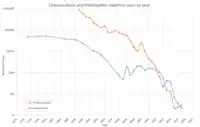Global Polio Eradication Initiative
The Global Polio Eradication Initiative is an initiative created in 1988, just after the World Health Assembly resolved to eradicate the disease poliomyelitis.[1] Led by the World Health Organization, it is the largest international public health initiative in history.[2]
| Global Polio Eradication Initiative (GPEI) | |
|---|---|
 .jpg.webp) .jpg.webp) .jpg.webp) .jpg.webp) .jpg.webp) text: GEPI, From Top left to right: Polio vaccination in India (2002), a morning briefing on how to vaccinate children in Pakistan, polio vaccine in the DRC, polio vaccination in Egypt, polio sequelle, checking for polio vaccination marks in Pakistan | |
| Country | Worldwide |
| Launched | 1988 |
| Website | Official website |
History
In 1987 Rotary International had begun a campaign to raise U.S. $100 million by its 100th anniversary, for the purpose of dealing with global polio.[3] The following year the World Health Assembly voted for the Global Polio Eradication Initiative. At the time there were 125 countries with endemic polio.[4] Efforts were built upon those used to control wild poliovirus in the Americas in the early 1980s and lessons from smallpox eradication.[1] Its first coordinator was Nick Ward.[5]
Strategy and structure
The strategy for the eradication of polio rests on immunising every at risk child until there is no one left for the disease to transmit to and the disease eventually dies out. The Initiative is spearheaded by the following organisations in the form of multistakeholder governance:
- WHO (World Health Organization) who are responsible for planning, technical direction, surveillance and eradication certification.
- Rotary International whose responsibilities include fundraising, advocacy, and volunteer recruitment.
- The CDC who are in charge of deploying scientists and public health experts to WHO and UNICEF.
- UNICEF is in charge of the distribution of the vaccine and helping countries develop communication and awareness strategies.
- The Gates Foundation as well provided a large portion of the funding.[6]
Key tactics used by the GPEI include strengthening childhood immunisation through oral vaccines, conducting surveillance through investigation of acute flaccid paralysis cases among children under 15 years old (in order to determine areas where the virus is truly eradicated), and conducting "mop up" campaigns in areas where cases of polio have been identified.[7]
Funding
At the peak of its work, the programme directly employed 4000 people across 75 countries and managed a budget of near U.S. $1 billion.[8]
By 2012 the GPEI had raised 9 billion dollars in funding[9] and in alone 2011 the GPEI received a 1.1 billion dollars, for a budget of 0.98 billion dollars. 30% of their funding came from the Gates Foundation 30% from developed governments, 27% from countries at risk of polio, and the rest was made up of donations from non profits, private funders, and other foundations. It is likely that the GPEI will become almost entirely funded by private organisations in the future.[10]
Evaluation
In 1995 the Global Certification Commission was created to oversee the certification of the eradication of wild-type poliovirus transmissions. Certification for the six WHO regions requires all of the countries in that region to be certified by the commission. By the year 2000 both the regions of the Western Pacific and the Americas met the criteria to be certified free of polio transmissions.[11] By 2012 the initial number of estimated cases in 1988 of 350,000 across 125 endemic countries had dropped to 650 confirmed cases. In addition, three of the six WHO regions are now certified polio eradicated (Europe, the Americas, The West Pacific). India, which many thought would face the greatest challenge to eradication was removed from the list of endemic countries. According to the most recent study by the GPEI, in 2016, there are only three countries still listed as endemic, Nigeria, Afghanistan and Pakistan.[12]
See also
- Eradication of infectious diseases
- The Final Inch, a short documentary about the effort to eradicate polio
- List of diseases eliminated from the United States
References
- Aylward, Bruce; Tangermann, Rudolf (December 30, 2011). "The global polio eradication initiative: Lessons learned and prospects for success". Vaccine. Smallpox Eradication after 30 Years: Lessons, Legacies and Innovations. 29: D80–D85. doi:10.1016/j.vaccine.2011.10.005. ISSN 0264-410X.
- Duintjer Tebbens, Radboud J.; et al. (December 16, 2010). "Economic analysis of the global polio eradication initiative". Vaccine. 29 (2): 334–343. doi:10.1016/j.vaccine.2010.10.026. ISSN 0264-410X.
- Brookes, Tim (2007). The End of Polio?: Behind the Scenes of the Campaign to Vaccinate Every Child on the Planet. American Public Health Association. p. 74. ISBN 978-0-87553-186-1.
- Hall, Robert G. (2011). "5. Political and social determinants of disease eradication". In Cochi, Stephen L.; Dowdle, Walter R. (eds.). Disease Eradication in the 21st Century: Implications for Global Health. Cambridge: The MIT Press. pp. 49–50. ISBN 978-0-262-01673-5.
- "Certification of Poliomyelitis Eradication". Fifteenth meeting of the European Regional Certification Commission Copenhagen, 19–21 June 2002, p. 25
- "Unicef's Engagement in the Global Polio Eradication Initiative" (PDF). Unicef.org. Retrieved June 21, 2016.
- Wassilak/Orenstein, Steven/Walter (2010). "Challenges faced by the global polio eradication initiative". Expert Review of Vaccines. 9 (5): 447–449. doi:10.1586/erv.10.45. PMID 20450316.
- Aylward, Bruce (2011). "2. Lessons from the late stages of the global polio eradication initiative". In Cochi, Stephen L.; Dowdle, Walter R. (eds.). Disease Eradication in the 21st Century: Implications for Global Health. Cambridge: The MIT Press. pp. 13–24. ISBN 978-0-262-01673-5.
- "Study on the Impact of Polio Eradication on Strengthening (Routine Immunization and Primary Health Care" (PDF). Middlebury College. Retrieved June 20, 2016.
- "Vaccination funding landscape". Givewell.org. Retrieved June 20, 2016.
- Technical Consultative Group to the World Health Organization on the Global Eradication of Poliomyelitis (2002). ""Endgame" Issues for the Global Polio Eradication Initiative". Clinical Infectious Diseases. 34: 72–77. doi:10.1086/338262. Retrieved June 20, 2016.
- "Data Monitoring". Global Polio Eradication Initiative. Retrieved June 20, 2016.
